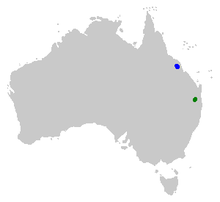| Gastric-brooding frogs | |
|---|---|

| |
| Southern gastric-brooding frog (Rheobatrachus silus) | |
| Scientific classification | |
| Domain: | Eukaryota |
| Kingdom: | Animalia |
| Phylum: | Chordata |
| Class: | Amphibia |
| Order: | Anura |
| Family: | Myobatrachidae |
| Genus: | †Rheobatrachus Liem, 1973 |
| Species | |

| |
| The former distributions of Rheobatrachus silus (green) and Rheobatrachus vitellinus (blue) | |
Rheobatrachus, whose members are known as the gastric-brooding frogs or platypus frogs, is a genus of extinct ground-dwelling frogs native to Queensland in eastern Australia. The genus consisted of only two species, the southern and northern gastric-brooding frogs, both of which became extinct in the mid-1980s. The genus is unique because it contains the only two known frog species that incubated the prejuvenile stages of their offspring in the stomach of the mother.[3]
The combined ranges of the gastric-brooding frogs comprised less than 2,000 square kilometres (770 sq mi). Both species were associated with creek systems in rainforests at elevations of between 350 and 1,400 metres (1,150 and 4,590 ft). The causes of the gastric-brooding frogs' extinction are not clearly understood, but habitat loss and degradation, pollution, and some diseases may have contributed.
The assignment of the genus to a taxonomic family is hotly debated. Some biologists class them within Myobatrachidae under the subfamily Rheobatrachinae, but others place them in their own family, Rheobatrachidae.[4] Molecular genetics finds it sister to Mixophyes.[5]
Scientists at the University of Newcastle and University of New South Wales announced in March 2013 that the frog would be the subject of a cloning attempt, referred to as the "Lazarus Project", to resurrect the species. Embryos were successfully cloned, and the project eventually hopes to produce a living frog.[6][7]
The southern gastric brooding frog has been listed as Extinct by the IUCN because it has not been recorded in the wild since 1981, and extensive searches over the last 35 years have failed to locate this species.
- ^ IUCN SSC Amphibian Specialist Group (2022). "Rheobatrachus silus". The IUCN Red List of Threatened Species. 2022. IUCN: e.T19475A78430533.
- ^ IUCN SSC Amphibian Specialist Group (2022). "Rheobatrachus vitellinus". The IUCN Red List of Threatened Species. 2022. IUCN: e.T19476A78430385.
- ^ Barker, J.; Grigg, G. C.; Tyler, M. J. (1995). A Field Guide to Australian Frogs. Surrey Beatty & Sons. p. 350. ISBN 0-949324-61-2.
- ^ Heyer, W. Ronald; Liem, David S. (1976). "Analysis of the inter-generic relationships of the Australian frog family Myobatrachidae" (PDF). Smithsonian Contributions to Zoology. 233 (233): 1–29. doi:10.5479/si.00810282.233.
- ^ Cite error: The named reference
molwas invoked but never defined (see the help page). - ^ Yong, Ed (15 March 2013). "Resurrecting the Extinct Frog with a Stomach for a Womb". National Geographic. Archived from the original on 18 March 2013. Retrieved 15 March 2013.
- ^ Dolak, Kevin (20 March 2013). "Frog That Gives Birth Through Mouth to be Brought Back From Extinction". ABC News.
